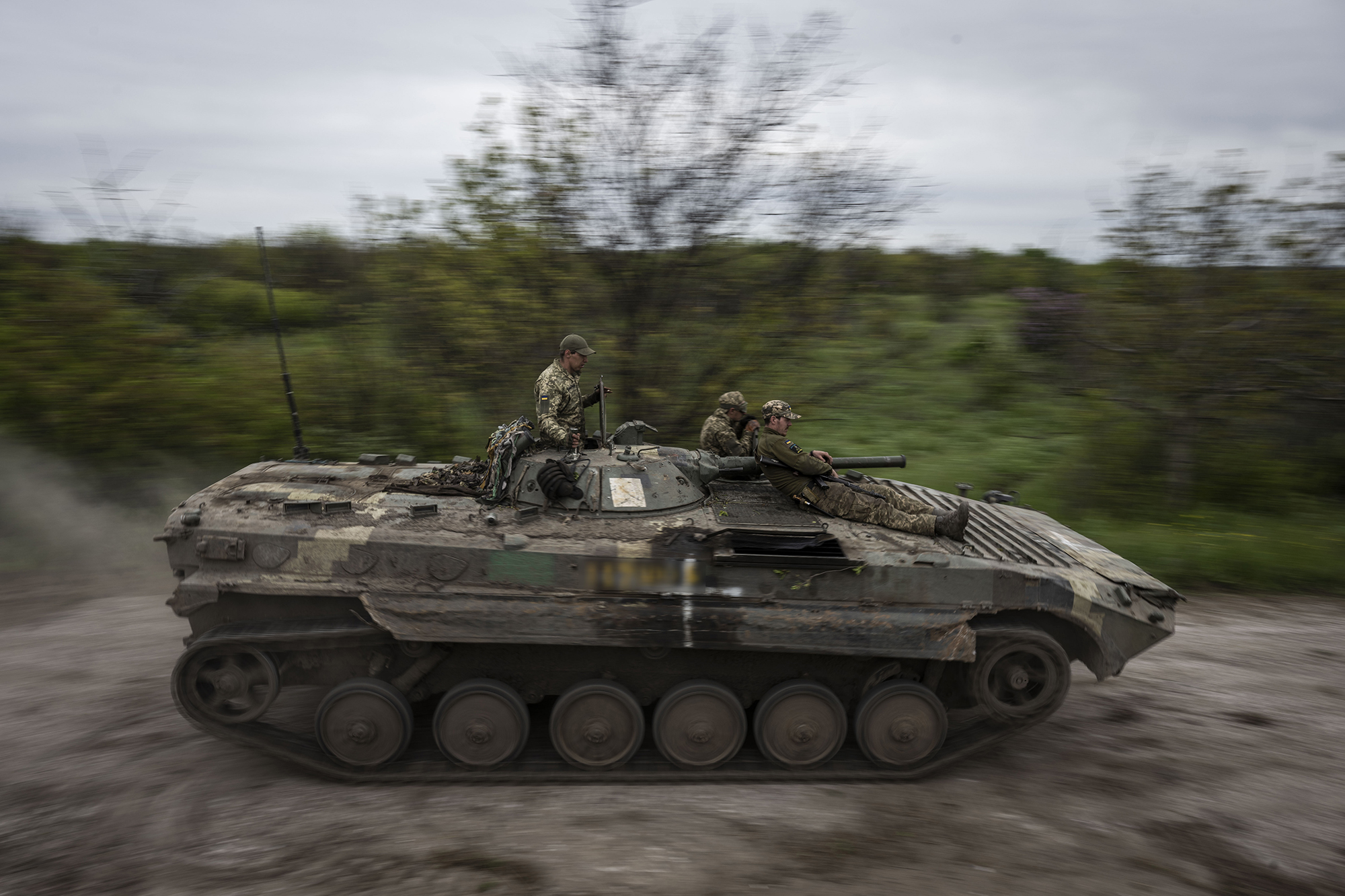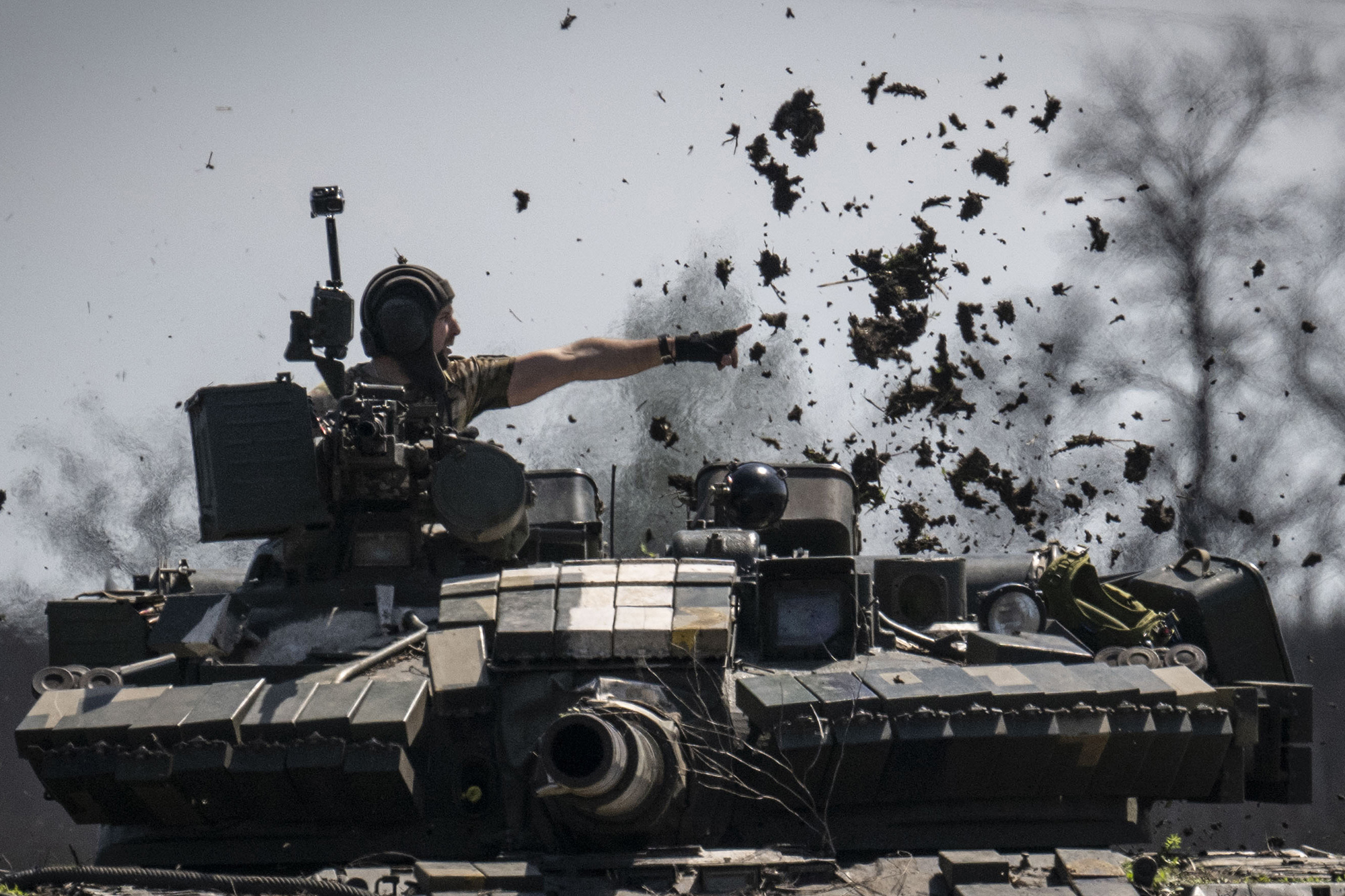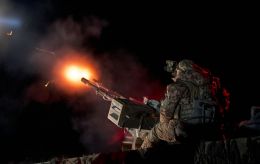Assault on Avdiivka and siege of Bakhmut - Situtation on the front and where to expect UAF breakthrough
 Ukrainian soldier with an anti-drone shotgun in the Luhansk region (Photo: Getty Images)
Ukrainian soldier with an anti-drone shotgun in the Luhansk region (Photo: Getty Images)
Fighting on the front lines is taking place for advantageous positions that will help the Armed Forces of Ukraine transition from tactical moves to strategic ones. Here's the analysis of what is happening in Avdiivka, why the Russians are holding Bakhmut at any cost, and what the situation in the Zaporizhzhia region is.
During the preparation of this material, comments from military experts Oleksii Hetman, Petro Chernyk, and Pavlo Narozhnyi were used, as well as information from official sources.
In the fifth month of the Ukrainian counteroffensive, it may seem that both the Russian army and the Ukrainian Armed Forces are locked in battles for mere meters of land on the front line, but this is not the case.
Heavy fighting is taking place in practically all directions, with the occupiers not achieving significant success and suffering losses in both personnel and military equipment. Experts analyzing the course of military actions today refer to them as a strategic routine. And in this routine, the initiative, it seems, is on the side of the Ukrainian military.
Avdiivka fortress
Russian occupation forces have been trying to capture Avdiivka since the beginning of hostilities in Eastern Ukraine. On February 21, 2022, fighting for it resumed, but so far, the Russians have not gotten the desired results.
Today, Avdiivka is witnessing another phase of heavy battles, and it appears to be nearing its conclusion. The enemy wants to encircle the city from the north and south – from Krasnohorivka and Vodyane, also attempting a frontal assault from the direction of Kruta Balka. Occupiers took Soledar and Bakhmut following a similar scheme. According to military analysts, the Russian army has once again bitten off more than they can chew in Avdiivka, suffering significant losses in personnel.
Recently, the occupiers lost nearly an entire division – 5,000 Russian soldiers were killed, and another 10,000 were wounded. In addition, according to BILD, the Russian armed forces lost over 60 tanks, armored personnel carriers, and other military equipment in recent battles for Avdiivka alone. Nonetheless, the Russians continue to build up their forces, and soon they may attempt to attack Avdiivka again.
There are two main objectives for capturing the city. One of them is undoubtedly military. Avdiivka is one of the closest cities to Donetsk and is under the control of the Ukrainian Armed Forces, which poses challenges for the Russian occupiers. Essentially, the entire Donetsk region is an agglomeration where one city seamlessly transitions into another. Yasynuvata, a powerful railway junction, is located near Avdiivka. Just 5 kilometers from the city is Donetsk Airport, and a bit further is the occupied city of Horlivka.

Ukrainian military on BMP-1 in Donetsk region (Photo: Getty Images)
Therefore, by holding Avdiivka, the Ukrainian military can maintain control over several strategically important points and logistical hubs, notes military expert Pavlo Narozhnyi.
"Avdiivka is like an appendix in the enemy's defense. It juts deep into their territory for about 10 kilometers. This is a precarious situation for the enemy. The shorter the front line, the better for them. They need to straighten the front line to ease the situation near Donetsk because it's very tense there," says Narozhnyi in a comment to RBC-Ukraine.
The other goal is political. Firstly, elections are approaching in Russia, and the current President Vladimir Putin wants to sell his personal victory to the Russian people. Bakhmut, captured by the Wagner Group, doesn't fit this role well due to conflicts between the Ministry of Defense and the former leader of the PMC Wagner Yevgeny Prigozhin. Sergey Shoigu and, accordingly, Putin needs to showcase their achievements. Avdiivka, as odd as it may seem in the context of last year's ambitions, is a suitable choice today, says military expert Petro Chernyk.
"Putin should enter the elections with the result that he has achieved his goals in the Russian Federation. I don't believe in any uprisings of the Russian people, but for the elites, it's a sign of his incompetence. That's why they are storming Avdiivka. But from a military perspective, it's a suicide," Chernyk notes in a comment to RBC-Ukraine.
Today, despite numerous attempts to capture Avdiivka, the Russians have not succeeded, and there are several reasons for this. The first reason is the strong fortifications defended by the Ukrainian Armed Forces. Avdiivka houses a coke chemical plant, a massive structure with concrete walls, and numerous underground tunnels. Many Ukrainian soldiers have been there with varying breaks since 2014 and know the territory well.
Furthermore, near the coke chemical plant, there is a slagheap, and at one point, the Russians were preoccupied with capturing it and controlling this height. However, they failed to do so, and the advantageous position remained under the control of the Ukrainian Armed Forces.
Unable to maintain constant fire due to a munition shortage, the Russians employ aviation, dropping guided bombs on the city, primarily from Su-25 aircraft. But to ensure a direct hit, the pilot needs to fly as close as possible, which means entering deep into the front lines. This poses a significant risk for the Russian army – in just one week, the Ukrainian Armed Forces shot down three attack aircraft - they approach a distance of approximately 30 kilometers, rapidly gain altitude, and release the bomb. Consequently, the accuracy of hitting the target is reduced, but it remains a problem for Ukrainian military forces.
It's worth noting that on the night of October 16 to 17, Special Operations Forces carried out a DRAGONFLY operation, during which they delivered artillery strikes on the airfields in the occupied cities of Luhansk and Berdyansk. As a result of the operation, the Russians lost nine helicopters, special equipment, an air defense missile system, and ammunition depots, which detonated in Berdyansk by 4 a.m. and in Luhansk by 11 a.m. The strikes also damaged the runways and eliminated a significant portion of the enemy's combat capability. Therefore, it is quite likely that the occupiers will be unable to shell Avdiivka with attack aircraft for some time.
In their efforts to distract the Ukrainian forces and capture the city, the Russians are expending a massive amount of resources on Avdiivka. While they may be able to mobilize an estimated 1.5 to 3 million people, they cannot produce the necessary equipment, especially armored vehicles, in such quantities. Thus, various innovations are being used, according to military analyst Pavlo Narozhnyi.
"We have already seen various 'exotic' units of equipment – some motorcycle gangs on which they weld armored turrets and machine guns. This means they are running out of armored vehicles, such as APCs and tanks. During assaults, this equipment is effectively destroyed, either on minefields or by anti-tank-guided missiles. In recent days, during the ongoing battles, we've seen around 30-40 tanks destroyed there, which is a significant number," Narozhnyi noted.
A similar situation occurred in the battles for Vuhledar, where Russia lost no less than 130 tanks and APCs during a three-week battle.
Creeping counteroffensive in Bakhmut
Details about the Bakhmut direction are provided by the soldiers themselves who document their battles. In the videos regularly published by the 3rd Assault Brigade, the fields around Bakhmut are covered in smoke from artillery shells, filled with craters where soldiers take cover from bullets, and uneven lines of burnt shrubs. This is the current state of the Bakhmut direction, where every meter reclaimed by the Ukrainian Armed Forces is gained through significant effort.
According to military observers, the situation on this front is indeed difficult but not hopeless. Today, the battles near Bakhmut are referred to as a "creeping counteroffensive" by the Ukrainian Armed Forces as they advance into enemy territory.

Ukrainian soldier with a grenade launcher (Photo: Getty Images)
"Every day, the Ukrainian Armed Forces reclaim a section of the front. It's just a matter of time before the Russians have to leave. I don't see any prospects for a Russian offensive there," noted Narozhnyi.
On the DeepState map, it's evident that the main battles are taking place to the south of Bakhmut, in places like Klishchiivka and Andriivka. The tactic is simple: encircle Bakhmut from the north and south, control the logistical routes of the occupiers, and force the Russians to either leave Bakhmut or surrender if they can't break out of the encirclement. However, in practice, it's more challenging than it sounds.
Combat clashes in the Bakhmut direction occur regularly, with the enemy subjecting the Ukrainian Armed Forces to heavy artillery fire and aviation attacks. In such conditions, the Ukrainian forces not only manage to repel attacks but also destroy Russian military equipment like Msta-B howitzers or Pion systems. Meanwhile, the Russians are shifting their counteroffensive reserve to the north of Bakhmut, and according to Illia Yevlash, the chief spokesperson of the East Military Group, they are panicking due to their losses on the southern front.
Initially, the Russians captured Bakhmut with the intention of using it as a foothold for further advances. They planned to amass resources there and break through the frontlines to the north, toward the Kupiansk-Lyman Group, and to the south, toward Vuhledar. This way, the Russian army aimed to encircle the Ukrainian Armed Forces from the south and north flanks. However, intense battles just a few kilometers from Bakhmut thwarted these plans, and now Bakhmut is seen as the occupiers' final destination, rather than a foothold, according to Oleksii Hetman, a retired major of the Ukrainian Armed Forces and military expert.
"Russians spoke about Bakhmut as if it was almost a victory in the war, comparing it to the Battle of Stalingrad. For them, losing Bakhmut now is unacceptable. Neither the civilian population in Russia nor the military personnel will understand them. We have chosen a tactic to encircle this city from the north and south," the expert says.
As for the Kupiansk-Lyman direction, there have been no recent breakthroughs from either side. This remains one of the main directions for future advances. In recent days, the enemy has managed to make limited advances, moving only a few hundred meters in the Orlyanka area. The enemy aims to advance to Kupiansk before the onset of winter, but Ukrainian forces have fortified engineering positions and placed explosive barriers, causing losses to the Russians. According to Yevlash, in the past day alone, the Ukrainian Armed Forces eliminated 163 occupiers and 24 pieces of equipment.
South front: Situation around Robotyne and Surovikin Line
At the end of July, it became known that Ukrainian forces had advanced to Robotyne in the Zaporizhzhia region. On August 22, they liberated it. Looking at the map, it is clear that the liberated village was literally wedged into the front line. Now, Russian forces are trying to bypass Robotyne from the flanks and encircle the Ukrainian forces, which, after liberating the village, came very close to the main line of the occupiers' defense – the so-called Surovikin Line.
This is a complex network of various fortifications, trenches, dragon teeth, and everything that the Russians could equip during the occupation. For them, it is important not only to encircle the Ukrainian Armed Forces but also to prevent them from advancing beyond this line of defense. Therefore, they have deployed an airborne assault division to the Robotyne area, which is defending and attempting to advance. Although in some areas around Robotyne and Verbove, Ukrainian units have already overcome the initial positions of the Surovikin Line and have even started using armored vehicles in this area.

Ukrainian tank operator (Photo: Getty Images)
Another reason why the Russians fear a breakthrough by the Ukrainian Armed Forces is the railway Volnovakha-Tokmak-Dzhankoy which runs into the Russian Federation. This is a vital logistical link for the Russians – they use it to supply their troops with equipment and manpower. For this reason, in recent days, the occupiers have intensified their activities to the south of Maryinka, aiming to push the Ukrainian Armed Forces as far away from Volnovakha as possible.
The Ukrainian Armed Forces have the railway under fire control, but even if they destroy it at one of the junctions, the Russian engineering forces can quickly restore it. Therefore, it is crucial to gain actual control over the road. According to Hetman, the Russians brought about 5,000 servicemen to the occupied Mariupol to have a backup supply route.
"I am confident that they have come to build a road along the coast of the Azov Sea to serve as a logistical artery. Because if we cut off both the railway and the Crimean Bridge, they won't be able to transport what they need. What they have in their operational depots will run out in a month or two," Hetman noted.
If the Ukrainian Armed Forces can cross the Surovikin Line and take control of the railway, it opens a path to Tokmak and Melitopol. "Further into the steppe. We have plenty of wheeled vehicles; we can move with fast strike columns, and they understand this very well. If we hypothetically reach the Molochnyi Estuary and establish a foothold there, they won't have an exit to Crimea," added Chernyk.
As for the Kherson direction, the situation remains unchanged today. Special Operations Forces soldiers are engaged in pinpoint battles, but the climatic conditions do not currently allow for significant battles by either the Ukrainian Armed Forces or the occupiers. Therefore, the Russians are focusing on shelling the right bank of the Kherson region, regularly killing civilians.
***
According to experts, today Russians have two main objectives - to reach the borders of Donetsk and Luhansk regions and to hold onto Bakhmut. The situation with the latter is clear. As for reaching the regional borders, Putin needs this for the legalization of his territory, which has even been enshrined in the Russian constitution. According to Chernyk, if the Russian army succeeds in this, it will exit from the south and announce the end of the war, emphasizing that it is now solely the fault of the Ukrainians.
"Every single day, I don't know how much time - maybe a month, maybe two, we will be in the zone of strategic routine. We have two strategic objectives - to quickly encircle Bakhmut and break through the Surovikin Line. They have two strategic objectives - to hold onto Bakhmut at any cost and to reach the borders of the Luhansk and Donetsk regions. Everything will happen under these four focuses until one side achieves its goal. And it will be like this for a long time," Chernyk added.

